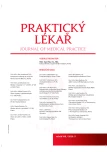Pelvic venous congestion syndrome in clinical practice of angiologist’s point of view
Authors:
P. Gavornik 1,2; A. Dukát 1,2; Ľ. Gašpar 1,2
Authors‘ workplace:
Angiologická sekcia Slovenskej lekárskej komory, Slovenská republika, Predseda: doc. MUDr. Peter Gavorník, PhD., mim. prof.
1; Lekárska fakulta Univerzity Komenského v Bratislave, Dekan: prof. MUDr. Juraj Šteňo, DrSc.
2
Published in:
Prakt. Lék. 2020; 100(1): 19-22
Category:
Of different specialties
Overview
Various urogenital, angiogenic, gastrointestinal, neurogenic, osteoartromuscular, psychosomatic and other disorders may cause or contribute to chronic pelvic pain. Sometimes, multiple contributing factors may exist in a single patient. Pelvic congestion syndrome: chronic symptoms, which may include pelvic pain, perineal heaviness, urgency of micturition, and post-coital pain, caused by ovarian and/or pelvic vein reflux and/or obstruction, and which may be associated with vulvar, perineal, and/or lower extremity varices. The VEIN-TERM consensus document was developed by a transatlantic interdisciplinary faculty of experts under the auspices of the American Venous Forum (AVF), the European Venous Forum (EVF), the International Union of Phlebology (IUP), the American College of Phlebology (ACP), and the International Union of Angiology (IUA). It provides recommendations for fundamental venous terminology. Project Vessels of AS SMC.
Keywords:
angiology/ vascular medicine – phlebology/ venous medicine – chronic venous disease (CVD) – pelvic congestion syndrome (PCS) – clinical practices
Sources
1. Eklof B, Perrin M, Delis KT, et al. Updated terminology of chronic venous disorders: The VEIN-TERM transatlantic interdisciplinary consensus document. J Vasc Surg 2011; 49(2): 498–501.
2. Taylor HC jr. Vascular congestion and hyperaemia; their effect on structure and function in the female reproductive system. Am J Obstet Gynecol 1949; 57(2): 211–230.
3. Gavorník P, Holomáň K, Gašpar Ľ, a kol. Syndróm vénovej panvovej kongescie – diagnóza a manažment. Odporúčanie Angiologickej sekcie Slovenskej lekárskej komory (2015). Vnitř. Lék. 2015; 61(3): 244–250.
4. Engeler D, Baranowski AP, Borovicka J, et al. Guidelines of chronic pelvic pain. Eur Urol 2013; 64(3): 431–439. Dostupné z: http://uroweb.org/wp-content/uploads/21-Chronic-Pelvic-Pain_LR_pocket.pdf [cit. 2019-09-27].
5. Dos Santos SJ, Holdstock JM, Harrison, et al. Ovarian vein diameter cannot be used as an indicator of ovarian venous reflux. Eur J Vasc Endovasc Surg 2015; 49(1): 90–94. Dostupné z: http://dx.doi.org/10.1016/j.ejvs.2014.10.013 [cit. 2019-09-27].
6. Nicolaides A, Kakkos S, Baekgaard N, et al. Management of chronic venous disorders of the lower limbs. Guidelines according to scientific evidence. Part I. Int Angiol 2018; 37(3): 181–254.
7. Rabe E, Guex J-J, Puskas A, et al. The VCP Coordinators. Epidemiology of chronic venous disorders in geographically diverse populations: results from the Vein Consult Program. Int Angiol 2012; 31(2): 105–115.
8. Gavorník P. Najčastejšie choroby vénového cievneho systému. Bratislava: Univerzita Komenského 2014.
9. Eklof B, Rutherford RB, Bergan JJ, et al. Revision of the CEAP classification for venous disorders: Consensus statement. J Vasc Surg 2004; 40(6): 1248–1252.
10. Rabe E, Breu F, Cavezzi A, et al. for the guideline group. European guidelines for sclerotherapy in chronic venous disorders. Phlebology 2014; 29(6): 338–354.
11. Gavorník P. Všeobecná angiológia. Angiologická propedeutika. Cievne choroby. 2. vydanie. Bratislava: Univerzita Komenského 2001.
12. Gašpar Ľ. 40. výročie vzniku prvého klinického angiologického pracoviska na Slovensku. Monitor medicíny SLS 2014; 4(3–4): 41–42.
13. Gavorník P. Angiológia 1 pre všeobecných praktických lekárov. Flebológia. Bratislava: Dr. Josef Raabe 2013.
14. Gavorník P. Angiológia 2 pre všeobecných praktických lekárov. Arteriológia. Bratislava: Dr. Josef Raabe 2014.
15. Clemens RK, Pfammatter T, Meier TO, et al. Vascular malformations revisited. Vasa 2015; 44(1): 5–22.
16. Barros BS, Kakkos SK, De Maeseneer M, Nicolaides AN. Chronic venous disease: from symptoms to microcirculation. Int Angiol 2019; 38(3): 211–219.
17. Antignani PL. Let’s talk about pelvic congestion syndrome. Acta Phlebol 2018; 19(3): 71–73.
18. Chernukha L, Kondratyuk V, Vlasenko O, Bobrova A. Pelvic congestion syndrome as a predisposing factor of „two-level“ varicose veins development. Acta Phlebol 2018; 19(3): 80–86.
19. Antignani PL, Lazarashvili Z, Monedero JL, et al. Diagnosis and treatment of pelvic congestion syndrome: UIP consensus document. Int Angiol 2019; 38(4): 265–283.
20. Mansilha A, Sousa J. Benefits of venoactive drug therapy in surgical or endovenous treatment for varicose veins: a systematic review. Int Angiol 2019; 38(4): 291–298.
Labels
General practitioner for children and adolescents General practitioner for adultsArticle was published in
General Practitioner

2020 Issue 1
Most read in this issue
- Patients with limited legal capacity in general practitioners’ surgeries: what is new in Czech legislation
- Using honey dressing in treatment of non-healing wounds in elderly
- Pelvic venous congestion syndrome in clinical practice of angiologist’s point of view
- Hypercholesterolemia therapy by PCSK9 inhibitors
